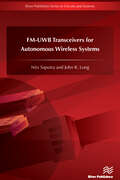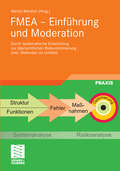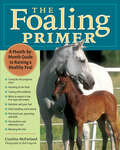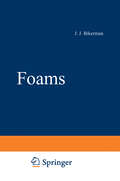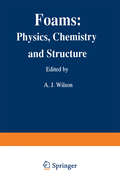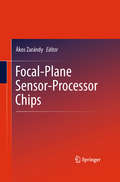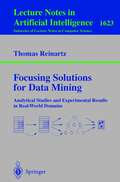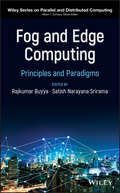- Table View
- List View
Flywheel Energy Storage: in Automotive Engineering
by Armin BuchroithnerStoring energy is one of the most important challenges of our time. Energy storage systems are not only essential for switching to renewable energy sources, but also for all mobile applications. Electro-mechanical flywheel energy storage systems (FESS) can be used in hybrid vehicles as an alternative to chemical batteries or capacitors and have enormous development potential. In the first part of the book, the Supersystem Analysis, FESS is placed in a global context using a holistic approach. External influences such as the vehicle, driver and operating strategy, including socio-psychological aspects, are analyzed with regard to their interaction with the memory. From this, optimal application scenarios are derived and the development goals relevant for market success are defined. In the second part, the consideration of the subsystem, those critical components in the FESS are identified which are responsible for the achievement of the technical target properties. From the point of view of maximum cost reduction, specific solutions for the design of the key components are presented and their suitability is validated through empirical studies on the housing, bearing and rotor as well as through overall prototypes.This book is a translation of the original German 1st edition Schwungradspeicher in der Fahrzeugtechnik by Armin Buchroithner published by Springer Fachmedien Wiesbaden GmbH, part of Springer Nature in 2019.
FM-UWB Transceivers for Autonomous Wireless Systems (River Publishers Series In Circuits And Systems Ser.)
by Nitz Saputra John R. LongSignificant research effort has been devoted to the study and realization of autonomous wireless systems for wireless sensor and personal-area networking, the internet of things, and machine-to-machine communications. Low-power RF integrated circuits, an energy harvester and a power management circuit are fundamental elements of these systems. An FM-UWB Transceiver for Autonomous Wireless Systems presents state-of-the-art developments in low-power FM-UWB transceiver realizations. The design, performance and implementation of prototype transceivers in CMOS technology are presented. A working hardware realization of an autonomous node that includes a prototype power management circuit is also proposed and detailed in this book.Technical topics include: Low-complexity FM-UWB modulation schemesLow-power FM-UWB transceiver prototypes in CMOS technologyCMOS on-chip digital calibration techniquesSolar power harvester and power management in CMOS for low-power RF circuitsAn FM-UWB Transceiver for Autonomous Wireless Systems is an ideal text and reference for engineers working in wireless communication industries, as well as academic staff and graduate students engaged in electrical engineering and communication systems research.
FM-UWB Transceivers for Autonomous Wireless Systems
by Nitz Saputra John R. LongSignificant research effort has been devoted to the study and realization of autonomous wireless systems for wireless sensor and personal-area networking, the internet of things, and machine-to-machine communications. Low-power RF integrated circuits, an energy harvester and a power management circuit are fundamental elements of these systems. An FM-UWB Transceiver for Autonomous Wireless Systems presents state-of-the-art developments in low-power FM-UWB transceiver realizations. The design, performance and implementation of prototype transceivers in CMOS technology are presented. A working hardware realization of an autonomous node that includes a prototype power management circuit is also proposed and detailed in this book.Technical topics include: Low-complexity FM-UWB modulation schemesLow-power FM-UWB transceiver prototypes in CMOS technologyCMOS on-chip digital calibration techniquesSolar power harvester and power management in CMOS for low-power RF circuitsAn FM-UWB Transceiver for Autonomous Wireless Systems is an ideal text and reference for engineers working in wireless communication industries, as well as academic staff and graduate students engaged in electrical engineering and communication systems research.
FMEA - Einführung und Moderation: Durch systematische Entwicklung zur übersichtlichen Risikominimierung (inkl. Methoden im Umfeld)
by Martin WerdichDieses Buch hilft Ihnen, die Methodik FMEA sowie die angrenzenden Themen zu verstehen und anzuwenden. Es räumt mit dem Vorurteil auf, FMEA wäre „nur“ ein Qualitätstool, das von Qualitätsspezialisten durchgeführt wird. Vielmehr kann die FMEA in jeder Branche als Werkzeug benutzt werden, um Produkte, Projekte, Aufgaben und Dienstleistungen äußerst planbar, nachvollziehbar und zielorientiert umzusetzen. Das strukturierte Vorgehen unterstützt Problemlösungen und schafft somit neue Denkansätze (präventive Qualitätssicherungsmethodik und Risikoanalyse). Bei richtiger Anwendung werden Sie Zeit, Geld und Kapazität einsparen.
FMEA - Einführung und Moderation: Durch systematische Entwicklung zur übersichtlichen Risikominimierung (inkl. Methoden im Umfeld)
by Martin WerdichDieses Buch hilft Ihnen, die Methodik FMEA sowie die angrenzenden Themen zu verstehen und anzuwenden. Es räumt mit dem Vorurteil auf, FMEA wäre „nur“ ein Qualitätstool, das von Qualitätsspezialisten durchgeführt wird. Vielmehr kann die FMEA in jeder Branche als Werkzeug benutzt werden, um Produkte, Projekte, Aufgaben und Dienstleistungen äußerst planbar, nachvollziehbar und zielorientiert umzusetzen. Das strukturierte Vorgehen unterstützt Problemlösungen und schafft somit neue Denkansätze (präventive Qualitätssicherungsmethodik und Risikoanalyse). Bei richtiger Anwendung werden Sie Zeit, Geld und Kapazität einsparen.
FMEA Using Uncertainty Theories and MCDM Methods
by Hu-Chen LiuThis book offers a thorough and systematic introduction to the modified failure mode and effect analysis (FMEA) models based on uncertainty theories (e.g. fuzzy logic, intuitionistic fuzzy sets, D numbers and 2-tuple linguistic variables) and various multi-criteria decision making (MCDM) approaches such as distance-based MCDM, compromise ranking MCDM and hybrid MCDM, etc. As such, it provides essential FMEA methods and practical examples that can be considered in applying FMEA to enhance the reliability and safety of products and services. The book offers a valuable guide for practitioners and researchers working in the fields of quality management, decision making, information science, management science, engineering, etc. It can also be used as a textbook for postgraduate and senior undergraduate students.
The Foaling Primer: A Step-by-Step Guide to Raising a Healthy Foal
by Cynthia McFarlandStart your foal off on the right hoof! With correct handling, health care, and training during the first year, you can establish a strong foundation that will benefit your horse throughout his life. From bottle feeding to rope leading, Cynthia McFarland covers everything you need to know as you guide your foal from birth to yearling. With an emphasis on recognizing critical developmental signs, McFarland&’s expert advice will help you raise a healthy, happy, and well-adjusted foal.
Foam Engineering: Fundamentals and Applications
by Paul StevensonContaining contributions from leading academic and industrial researchers, this book provides a much needed update of foam science research. The first section of the book presents an accessible summary of the theory and fundamentals of foams. This includes chapters on morphology, drainage, Ostwald ripening, coalescence, rheology, and pneumatic foams. The second section demonstrates how this theory is used in a wide range of industrial applications, including foam fractionation, froth flotation and foam mitigation. It includes chapters on suprafroths, flotation of oil sands, foams in enhancing petroleum recovery, Gas-liquid Mass Transfer in foam, foams in glass manufacturing, fire-fighting foam technology and consumer product foams. Key features: Foam fractionation is an exciting and emerging technology, starting to gain significant attention Discusses a vital topic for many industries, especially mineral processing, petroleum engineering, bioengineering, consumer products and food sector Links foam science theory to industrial applications, making it accessible to an engineering science audience Summarizes the latest developments in this rapidly progressing area of research Contains contributions from leading international researchers from academia and industry
Foam Engineering: Fundamentals and Applications
by Paul StevensonContaining contributions from leading academic and industrial researchers, this book provides a much needed update of foam science research. The first section of the book presents an accessible summary of the theory and fundamentals of foams. This includes chapters on morphology, drainage, Ostwald ripening, coalescence, rheology, and pneumatic foams. The second section demonstrates how this theory is used in a wide range of industrial applications, including foam fractionation, froth flotation and foam mitigation. It includes chapters on suprafroths, flotation of oil sands, foams in enhancing petroleum recovery, Gas-liquid Mass Transfer in foam, foams in glass manufacturing, fire-fighting foam technology and consumer product foams. Key features: Foam fractionation is an exciting and emerging technology, starting to gain significant attention Discusses a vital topic for many industries, especially mineral processing, petroleum engineering, bioengineering, consumer products and food sector Links foam science theory to industrial applications, making it accessible to an engineering science audience Summarizes the latest developments in this rapidly progressing area of research Contains contributions from leading international researchers from academia and industry
Foam Extrusion: Principles and Practice, Second Edition
Combining the science of foam with the engineering of extrusion processes, Foam Extrusion: Principles and Practice delivers a detailed discussion of the theory, design, processing, and application of degradable foam extraction. In one comprehensive volume, the editors present the collective expertise of leading academic, research, and industry spec
Foam Fractionation: Principles and Process Design
by Paul Stevenson Xueliang LiFoam fractionation is a separation process in which proteins and other amphipathic species adsorb to the surface of bubbles. The bubbles are then removed from the solution in the form of foam at the top of a column. Due to its cost-effectiveness, foam fractionation has the potential for rapid commercial growth, especially in biotechnology.To assist
Foams (Applied Physics and Engineering #10)
by J.J. BikermanThe book Foams: Theory and Industrial Applications, written by the undersigned and three collaborators and published in 1953, is still the only monograph on liquid foam in the English language. Naturally the science of foams had advanced in the intervening years so that a practically new book had to be prepared to give justice to the present state of our know ledge. This monograph has only one author and does not deal with solid foams, fire-fighting foams, and flotation, on which information is available elsewhere. The other applications of foam and its fundamental properties are reviewed at length and, whenever possible, attempts are made to reach the truth through a maze of conflicting evidence. February 1973 J. J. BIKERMAN Contents page Preface . v 1. General. Foam Films (Sections 1-22) 1 Foam Films 5 References 30 2. Formation and Structure (Sections 23-42) 33 Dispersion Methods 33 Condensation Methods 51 Foam Structure 59 References 62 3. Measurement of Foaminess (Sections 43-62) 65 Films and Bubbles 66 Foams. 76 References 94 4. Results of Foaminess Measurements (Sections 63-84) . 98 Poorly Foaming Liquids . 98 Strongly Foaming Liquids 108 Other Systems 132 References 140 5. Three-phase Foams (Sections 85-90) 149 References 157 6. Foam Drainage (Sections 91-106) 159 Experimental Data . 173 References 181 7. Mechanical Properties of Foams (Sections 107-122) 184 References 211 8. Optical Properties of Foams (Sections 123 -127) . 214 References 222 vii viii Contents 9.
Foams and Emulsions (NATO Science Series E: #354)
by J. F. Sadoc N. RivierA general and introductory survey of foams, emulsions and cellular materials. Foams and emulsions are illustrations of some fundamental concepts in statistical thermodynamics, rheology, elasticity and the physics and chemistry of divided media and interfaces. They also give rise to some of the most beautiful geometrical shapes and tilings, ordered or disordered. The chapters are grouped into sections having fairly loose boundaries. Each chapter is intelligible alone, but cross referencing means that the few concepts that may not be familiar to the reader can be found in other chapters in the book. Audience: Research students, researchers and teachers in physics, physical chemistry, materials science, mechanical engineering and geometry.
Foams: Physics, Chemistry and Structure (Springer Series in Applied Biology)
by Ashley J. WilsonFoams and froths are an important feature of everyday life; one only has to think of shaving foam, foam upholstery, fire fighting foam, bread, bear head, and ice cream. Less obvious but equally important are the foams and foaming processes which are being exploited in ever more complex and imaginative ways in industry. However, the unusual nature of foams, the fact that they are neither solids or liquids, and their very fragility has prevented scientists from obtaining a thorough understanding of even the basic principles of foam formation and stability. This volume presents papers on the physics, chemistry, structure and ultrastructure of foams by contributors from a wide range of backgrounds and research disciplines. The aim of the book is to present a unique multi-disciplinary cross section of work currently being undertaken on the subject of foams.
Focal-Plane Sensor-Processor Chips
by Ákos ZarándyFocal-plane sensor-processor imager devices are sensor arrays and processor arrays embedded in each other on the same silicon chip. This close coupling enables ultra-fast processing even on tiny, low power devices, because the slow and energetically expensive transfer of the large amount of sensory data is eliminated. This technology also makes it possible to produce locally adaptive sensor arrays, which can (similarly to the human retina) adapt to the large dynamics of the illumination in a single scene This book focuses on the implementation and application of state-of-the-art vision chips. It provides an overview of focal plane chip technology, smart imagers and cellular wave computers, along with numerous examples of current vision chips, 3D sensor-processor arrays and their applications. Coverage includes not only the technology behind the devices, but also their near- and mid-term research trends.
The Focus and Leverage Improvement Book: Locating and Eliminating the Constraining Factor of Your Lean Six Sigma Initiative
by Bob SproullCompanies all over the world try their best to improve their business by implementing efforts such as Six Sigma, Lean Manufacturing, or a combination of the two methodologies. Logic would tell you that these two methods would be the right approach because you would have an improvement method that, through Lean, reduces waste and make value flow, while Six Sigma reduces and controls variation. If this were true, then why is it that many of these initiatives simply aren’t delivering quantifiable bottom-line results? After having studied many of these on-going improvement efforts, the author believes that these efforts are missing an important focusing mechanism. That is, most of these improvement efforts attempt to improve "everything" rather than finding that key part of the system that should be assessed and improved, the constraining factor, and then focusing the improvement efforts there and only there. The hallmark of this book is how to first locate this constraining factor and then determine the best way to exploit it to generate extreme profits, radically improve on-time delivery of products or services and increase market share by outperforming your competition at rates you never expected possible. How do we do this? By combining Lean and Six Sigma with the Theory of Constraints. This book demonstrates both the basics of improvement (i.e. results) with the "how to" (i.e. the methodology) in a very simple format that everyone within your organization will understand.
The Focus and Leverage Improvement Book: Locating and Eliminating the Constraining Factor of Your Lean Six Sigma Initiative
by Bob SproullCompanies all over the world try their best to improve their business by implementing efforts such as Six Sigma, Lean Manufacturing, or a combination of the two methodologies. Logic would tell you that these two methods would be the right approach because you would have an improvement method that, through Lean, reduces waste and make value flow, while Six Sigma reduces and controls variation. If this were true, then why is it that many of these initiatives simply aren’t delivering quantifiable bottom-line results? After having studied many of these on-going improvement efforts, the author believes that these efforts are missing an important focusing mechanism. That is, most of these improvement efforts attempt to improve "everything" rather than finding that key part of the system that should be assessed and improved, the constraining factor, and then focusing the improvement efforts there and only there. The hallmark of this book is how to first locate this constraining factor and then determine the best way to exploit it to generate extreme profits, radically improve on-time delivery of products or services and increase market share by outperforming your competition at rates you never expected possible. How do we do this? By combining Lean and Six Sigma with the Theory of Constraints. This book demonstrates both the basics of improvement (i.e. results) with the "how to" (i.e. the methodology) in a very simple format that everyone within your organization will understand.
A Focus on SLM and SLS Methods in 3D Printing (Emerald Gems)
by Emerald Group LimitedA Focus on SLM and SLS Methods in 3D Printing is an indispensable collection of articles for anyone involved in additive manufacturing - from academics and researchers through to engineers and managers within the manufacturing industry. The collection features examples of innovative research involving selective laser melting and selective laser sintering techniques applied across a range of contexts.
Focused Quality: Managing for Results
by Paul MurphyFocused Quality: Managing for Results is a book about using quality improvement as a means to enhance bottom line results. Written for managers in industry, services, healthcare and government, this important new book provides a focused approach on how to target critical improvement initiatives and insure their success.Prepare - Plan - Deploy - Transition are the steps in the improvement process that are covered in detail. Included are examples of how organizations have successfully accomplished each step. Practical lessons on how to and how not to implement quality and process improvement initiatives are given.Process assessment is crucial to identifying the importance of a process and defining the scope of what is involved in order to improve it. Before deciding to refine, redesign or reengineer an assessment is needed. Focused Quality: Managing for Results not only shows you how to do an assessment but also how to apply the results to improve the bottom line.Application is emphasized throughout the book with the focus on the managers role in leading the change effort. The authors have provided a set of questions that management should answer to determine if their organization is ready to effectively implement the improvement process. Realizing that even the best plans can go astray there is also a diagnostic check sheet to pinpoint the causes of and solutions for process improvement failures.
Focused Quality: Managing for Results
by Paul MurphyFocused Quality: Managing for Results is a book about using quality improvement as a means to enhance bottom line results. Written for managers in industry, services, healthcare and government, this important new book provides a focused approach on how to target critical improvement initiatives and insure their success.Prepare - Plan - Deploy - Transition are the steps in the improvement process that are covered in detail. Included are examples of how organizations have successfully accomplished each step. Practical lessons on how to and how not to implement quality and process improvement initiatives are given.Process assessment is crucial to identifying the importance of a process and defining the scope of what is involved in order to improve it. Before deciding to refine, redesign or reengineer an assessment is needed. Focused Quality: Managing for Results not only shows you how to do an assessment but also how to apply the results to improve the bottom line.Application is emphasized throughout the book with the focus on the managers role in leading the change effort. The authors have provided a set of questions that management should answer to determine if their organization is ready to effectively implement the improvement process. Realizing that even the best plans can go astray there is also a diagnostic check sheet to pinpoint the causes of and solutions for process improvement failures.
Focusing Solutions for Data Mining: Analytical Studies and Experimental Results in Real-World Domains (Lecture Notes in Computer Science #1623)
by Thomas ReinartzIn the first part, this book analyzes the knowledge discovery process in order to understand the relations between knowledge discovery steps and focusing. The part devoted to the development of focusing solutions opens with an analysis of the state of the art, then introduces the relevant techniques, and finally culminates in implementing a unified approach as a generic sampling algorithm, which is then integrated into a commercial data mining system. The last part evaluates specific focusing solutions in various application domains. The book provides various appendicies enhancing easy accessibility.The book presents a comprehensive introduction to focusing in the context of data mining and knowledge discovery. It is written for researchers and advanced students, as well as for professionals applying data mining and knowledge discovery techniques in practice.
Fodder Crops and Amenity Grasses (Handbook of Plant Breeding #5)
by Beat Boller Ulrich K. Posselt Fabio VeronesiGrassland farming in Europe was already established during the settlement of the rst farmers together with their domesticated animals after the last ice age. Since then, grassland provides the forage basis to feed ruminant animals for the p- duction of meat and milk. Depending on the ecological conditions and intensity of usage, various plant communities with different species developed, displaying a rich biodiversity. With the introduction of improved crop rotations at the end of the 16th century, grasses and legumes were also grown to an important extent as forage crops on arable land. In the last decades the importance of amenity grasses increased markedly, due to the demand of the society for new usages like landscape protection. Around 1900 interested farmers and academics identi ed the need for gra- land improvement through systematic selection and seed production. This marks the beginning of breeding and research in companies but also at universities and specialized research institutes. Plant collection started with many of the species that are still of importance today. The collected materials were grouped according to the intended use and some type of phenotypic selection was applied. Seed mul- plication of such populations was performed in pure stands and the harvested seed was marketed. Although the vegetative biomass and its quality are of utmost imp- tance in forage crop breeding, it is the seed yield potential which determines the commercial success of a new variety.
Fog and Edge Computing: Principles and Paradigms (Wiley Series on Parallel and Distributed Computing)
by Rajkumar Buyya Satish Narayana SriramaA comprehensive guide to Fog and Edge applications, architectures, and technologies Recent years have seen the explosive growth of the Internet of Things (IoT): the internet-connected network of devices that includes everything from personal electronics and home appliances to automobiles and industrial machinery. Responding to the ever-increasing bandwidth demands of the IoT, Fog and Edge computing concepts have developed to collect, analyze, and process data more efficiently than traditional cloud architecture. Fog and Edge Computing: Principles and Paradigms provides a comprehensive overview of the state-of-the-art applications and architectures driving this dynamic field of computing while highlighting potential research directions and emerging technologies. Exploring topics such as developing scalable architectures, moving from closed systems to open systems, and ethical issues rising from data sensing, this timely book addresses both the challenges and opportunities that Fog and Edge computing presents. Contributions from leading IoT experts discuss federating Edge resources, middleware design issues, data management and predictive analysis, smart transportation and surveillance applications, and more. A coordinated and integrated presentation of topics helps readers gain thorough knowledge of the foundations, applications, and issues that are central to Fog and Edge computing. This valuable resource: Provides insights on transitioning from current Cloud-centric and 4G/5G wireless environments to Fog Computing Examines methods to optimize virtualized, pooled, and shared resources Identifies potential technical challenges and offers suggestions for possible solutions Discusses major components of Fog and Edge computing architectures such as middleware, interaction protocols, and autonomic management Includes access to a website portal for advanced online resources Fog and Edge Computing: Principles and Paradigms is an essential source of up-to-date information for systems architects, developers, researchers, and advanced undergraduate and graduate students in fields of computer science and engineering.
Fog and Edge Computing: Principles and Paradigms (Wiley Series on Parallel and Distributed Computing)
by Rajkumar Buyya Satish Narayana SriramaA comprehensive guide to Fog and Edge applications, architectures, and technologies Recent years have seen the explosive growth of the Internet of Things (IoT): the internet-connected network of devices that includes everything from personal electronics and home appliances to automobiles and industrial machinery. Responding to the ever-increasing bandwidth demands of the IoT, Fog and Edge computing concepts have developed to collect, analyze, and process data more efficiently than traditional cloud architecture. Fog and Edge Computing: Principles and Paradigms provides a comprehensive overview of the state-of-the-art applications and architectures driving this dynamic field of computing while highlighting potential research directions and emerging technologies. Exploring topics such as developing scalable architectures, moving from closed systems to open systems, and ethical issues rising from data sensing, this timely book addresses both the challenges and opportunities that Fog and Edge computing presents. Contributions from leading IoT experts discuss federating Edge resources, middleware design issues, data management and predictive analysis, smart transportation and surveillance applications, and more. A coordinated and integrated presentation of topics helps readers gain thorough knowledge of the foundations, applications, and issues that are central to Fog and Edge computing. This valuable resource: Provides insights on transitioning from current Cloud-centric and 4G/5G wireless environments to Fog Computing Examines methods to optimize virtualized, pooled, and shared resources Identifies potential technical challenges and offers suggestions for possible solutions Discusses major components of Fog and Edge computing architectures such as middleware, interaction protocols, and autonomic management Includes access to a website portal for advanced online resources Fog and Edge Computing: Principles and Paradigms is an essential source of up-to-date information for systems architects, developers, researchers, and advanced undergraduate and graduate students in fields of computer science and engineering.
Fog and Fogonomics: Challenges and Practices of Fog Computing, Communication, Networking, Strategy, and Economics (Information and Communication Technology Series, #57)
by Yang Yang Jianwei Huang Tao Zhang Joe WeinmanTHE ONE-STOP RESOURCE FOR ANY INDIVIDUAL OR ORGANIZATION CONSIDERING FOG COMPUTING Fog and Fogonomics is a comprehensive and technology-centric resource that highlights the system model, architectures, building blocks, and IEEE standards for fog computing platforms and solutions. The "fog" is defined as the multiple interconnected layers of computing along the continuum from cloud to endpoints such as user devices and things including racks or microcells in server closets, residential gateways, factory control systems, and more. The authors—noted experts on the topic—review business models and metrics that allow for the economic assessment of fog-based information communication technology (ICT) resources, especially mobile resources. The book contains a wide range of templates and formulas for calculating quality-of-service values. Comprehensive in scope, it covers topics including fog computing technologies and reference architecture, fog-related standards and markets, fog-enabled applications and services, fog economics (fogonomics), and strategy. This important resource: Offers a comprehensive text on fog computing Discusses pricing, service level agreements, service delivery, and consumption of fog computing Examines how fog has the potential to change the information and communication technology industry in the next decade Describes how fog enables new business models, strategies, and competitive differentiation, as with ecosystems of connected and smart digital products and services Includes case studies featuring integration of fog computing, communication, and networking systems Written for product and systems engineers and designers, as well as for faculty and students, Fog and Fogonomics is an essential book that explores the technological and economic issues associated with fog computing.

